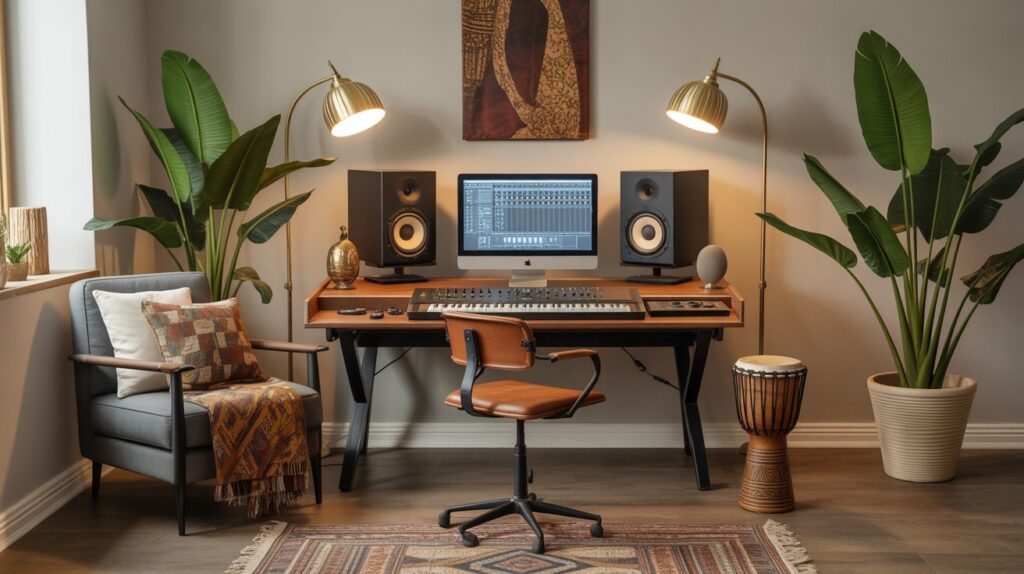Afrobeat has grown to be one of the most influential genres in the music world today, blending African rhythms with elements of jazz, funk, and contemporary pop. Its infectious energy and groovy beats make it a favorite among both listeners and producers.
If you want to learn how to make Afrobeat type beats, this step-by-step guide will help you craft the perfect track. Along the way, we’ll show you how to enhance your production using high-quality sample packs, MIDI kits, and Amapiano elements to add a unique flair to your Afrobeat beats.
Step 1: Set the Tempo and Create the Groove
Afrobeat typically runs between 95-110 BPM, giving it a medium-paced, danceable rhythm. Setting the right tempo is essential to capturing the upbeat vibe of Afrobeat. Begin by establishing a basic groove with your kick, snare, and hi-hats.
- Use a punchy kick on beats 1 and 3, while adding a snare or rimshot on beats 2 and 4 to create a traditional four-on-the-floor rhythm.
- Layer in hi-hats with syncopated patterns, which are common in Afrobeat to create movement. You can find great hi-hat samples in most Afrobeat sample packs.

Step 2: Add Percussion and Fill the Rhythm
One of the defining characteristics of Afrobeat is its complex and dynamic percussion. It’s all about layering different percussive elements to form a rich, rhythmic foundation.
- Use congas, bongos, and shakers to add depth to your groove. High-quality Amapiano elements can also work well, providing a fresh twist to traditional Afrobeat rhythms.
- Browse through an Afrobeat sample pack for authentic percussive loops that can save time and bring more life to your beat. Percussion is key to maintaining that vibrant Afrobeat energy.
Step 3: Create a Catchy Bassline
The bassline in Afrobeat is typically groovy and repetitive, locking in with the drums and percussion to provide a solid foundation. This is where the rhythm truly comes to life.
- Use an Afrobeat MIDI kit to drag and drop pre-made basslines, or create your own by focusing on simplicity and groove.
- The bass should complement the kick drum, emphasizing the downbeat while adding syncopated notes to maintain that Afrobeat bounce.

Step 4: Lay Down Chords and Melodies
Chords and melodies in Afrobeat are often played on keys, guitars, or brass instruments, with a strong focus on harmony. Choose a warm, clean electric piano or guitar sound to start.
- Begin with a simple chord progression using triads or 7th chords to add a touch of soul. If you need help finding the right chords, try using an Afrobeat MIDI kit to access pre-made chord progressions that fit well within the genre.
- Once you have the chords, add a lead melody. This can be played on a guitar, synth, or brass instrument. Keep it catchy and repetitive to ensure it sticks in the listener’s head.
Step 5: Add Vocals or Vocal Samples
Vocals play an important role in Afrobeat, often consisting of chants or call-and-response patterns that create an interactive feel. If you don’t have a vocalist, you can use vocal samples to enhance your beat.
- Look for Afrobeat vocal samples in a sample pack, or create your own vocal chops. Layer them in during key sections of the beat, such as the hook or bridge.
- You can also add vocal effects like reverb and delay to give the vocals a spacious, ambient quality.
Step 6: Add Amapiano Elements for a Unique Twist
To stand out, consider blending Amapiano elements into your Afrobeat beat. The log drum, a signature sound in Amapiano, can add a unique rhythmic and melodic element that sets your production apart.
- Use a log drum MIDI file from an Amapiano kit to add a rhythmic counterpoint to the bassline. This creates a hybrid sound that merges the best of Afrobeat and Amapiano, resulting in a fresh and unique production.
- Experiment with Afrobeat percussion like shakers and claves, which can help add a different layer to your groove and make your track more dynamic.

Step 7: Arrange Your Beat
Afrobeat tracks are known for their dynamic arrangements that keep the listener engaged. A typical arrangement might include:
- Intro: Start with a percussion loop or a vocal sample to introduce the groove.
- Verse: Introduce the kick, snare, bassline, and chord progression.
- Chorus: Add more layers, such as lead melodies, vocal samples, and additional percussion.
- Bridge: Strip back the elements to create a breakdown, then gradually build back up to the chorus.
- Outro: Slowly remove the elements until just the percussion or chords remain.
Step 8: Mix and Master Your Beat
The final step is to mix and master your Afrobeat beat to ensure it sounds professional and polished.
- Use EQ to make space for each element in the mix. Cut unnecessary low frequencies from non-bass instruments, and make sure the kick and bass are sitting well together.
- Apply compression to control the dynamics of your drums and bassline, making sure everything sounds tight.
- Add reverb and delay to create a sense of space, particularly on the chords, melodies, and vocal samples.
Once your mix is complete, apply a mastering chain to bring up the overall loudness without compromising the groove or dynamics.
WATCH A TUTORIAL:
Download Royalty-FREE! Afrobeat Sample Packs
To help you create amazing Afrobeat beats, make sure to download our high-quality Afrobeat sample packs from here. With a collection of drums, percussion, vocal samples, and more, you’ll have everything you need to craft professional-sounding beats, and yes it’s 100% Royalty-FREE!
Conclusion
Creating Afrobeat type beats is all about capturing the rhythm, energy, and vibrancy of the genre. By following this step-by-step guide and using Afrobeat sample packs, MIDI kits, and even some Amapiano elements, you can create unique, engaging beats that truly stand out. Remember to keep it groovy, keep it fun, and experiment with different sounds to develop your own signature style. Happy beatmaking!
FAQ: How to Make Afrobeat Type Beats
Q1: What is the typical BPM for Afrobeat type beats?
A: Afrobeat type beats generally range from 95 to 110 BPM. This tempo allows for a groovy, danceable rhythm that’s characteristic of the genre.
Q2: What instruments are essential for creating Afrobeat beats?
A: Essential instruments include percussion elements like congas, bongos, and shakers, as well as bass, electric piano, guitars, and sometimes brass instruments for chords and melodies. These instruments help create the rich, dynamic texture Afrobeat is known for.
Q3: How can I use MIDI kits to make Afrobeat beats?
A: MIDI kits can help you easily create basslines, chord progressions, and melodies. Simply drag and drop a MIDI file into your DAW, and adjust it to fit the vibe of your track. This can save time and ensure your beat has the right harmonic foundation.
Q4: What makes a good Afrobeat bassline?
A: A good Afrobeat bassline is groovy and repetitive, syncing well with the drums and percussion. It should emphasize the downbeat while adding syncopated notes to keep the beat moving and energetic.
Q5: How do I incorporate Amapiano elements into an Afrobeat beat?
A: You can incorporate Amapiano elements such as the log drum to add a melodic and rhythmic counterpoint to your bassline. Amapiano percussion like shakers and claves can also bring a different layer of depth to your Afrobeat production.
Q6: Where can I find quality samples and MIDI kits for Afrobeat production?
A: You can find high-quality Afrobeat sample packs and MIDI kits on our website. These packs include everything from drums to melodies, helping you create professional-sounding Afrobeat beats. (Download Afrobeat Sample Packs from here) 100% Royalty-FREE!
Q7: How can I create a professional-sounding Afrobeat mix?
A: To create a professional-sounding mix, use EQ to carve out space for each element, apply compression to control dynamics, and add reverb and delay to create space and depth. Ensuring that your kick and bass sit well together is also crucial for a clean and powerful low end.
Q8: What should be included in a typical Afrobeat arrangement?
A: A typical Afrobeat arrangement includes an intro (with percussion or vocal samples), verse (introducing kick, snare, bass, and chords), chorus (adding more layers like melodies and vocal samples), bridge (a breakdown to create contrast), and an outro (stripping back elements to conclude the beat).
Q9: How can I add vocals if I don’t have a vocalist?
A: You can use vocal samples found in Afrobeat sample packs. Layer them in key sections of your beat, such as the hook or bridge, and apply effects like reverb and delay to enhance their presence in the mix.
Q10: How do I market and sell my Afrobeat beats?
A: You can market your beats through social media, beat marketplaces, and your own website. Collaborate with artists, promote on platforms like YouTube, and build a community of followers interested in Afrobeat to increase your sales potential.